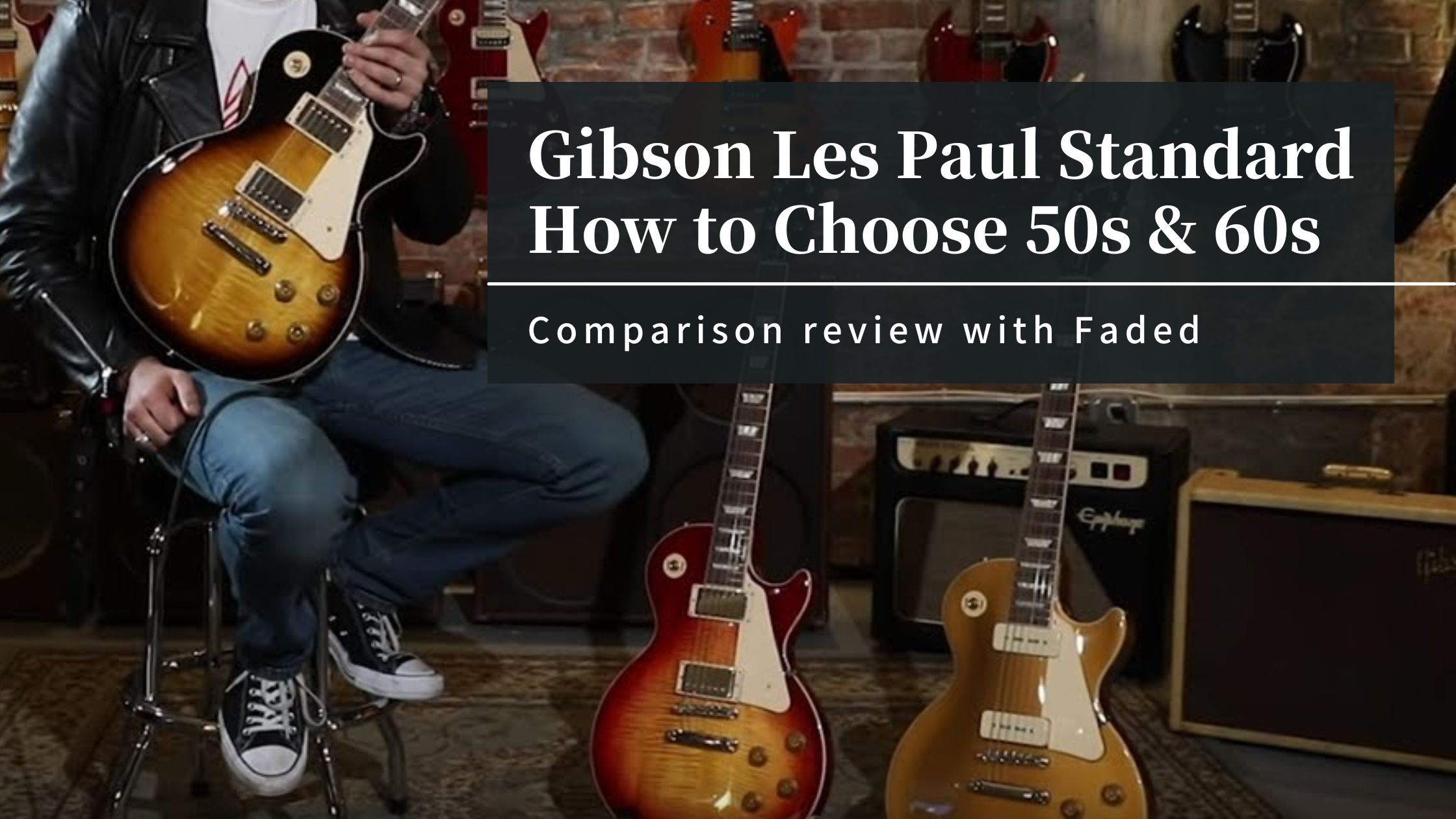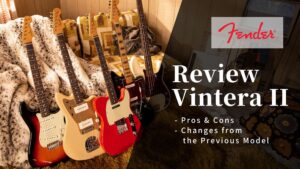Les Paul Standard, produced in Gibson USA's regular line, is a classic and orthodox model. Compared to the custom shop and vintage, it's a bit different, but it has a satisfying sound, playability, and look that says, "This is a Les Paul." There are criticisms that Gibson's current quality is low, but personally, I think it's not a concern. The Les Paul Standard Faded, with its simplified paint job, is a novelty with its satin finish. The 50s and 60s look slightly different, with the thick neck of the 50s and the thin neck of the 60s, and the sound is also slightly different. If you want a straightforward Les Paul, including its quirks, the 50s is recommended. If you're looking for universal playability, the 60s is recommended.
If you are those who:
● Want to know more about Gibson’s Les Paul.
● What’s the difference between the 50s and 60s?
● What is Les Paul Standard Faded?
● I want a regular Gibson Les Paul, but I don’t know which one to buy.
I am Yosh, an ex-musical instrument store clerk (@Yosh_Guitar), explain in detail about the Gibson Les Paul Standard, the most standard model currently available.
Pros of Gibson Les Paul Standard
- Distinguished USA-made Gibson
- Orthodox and Luxurious Looks
- Authentic Les Paul Sound
- High Quality and Easy to Play
Distinguished USA-made Gibson
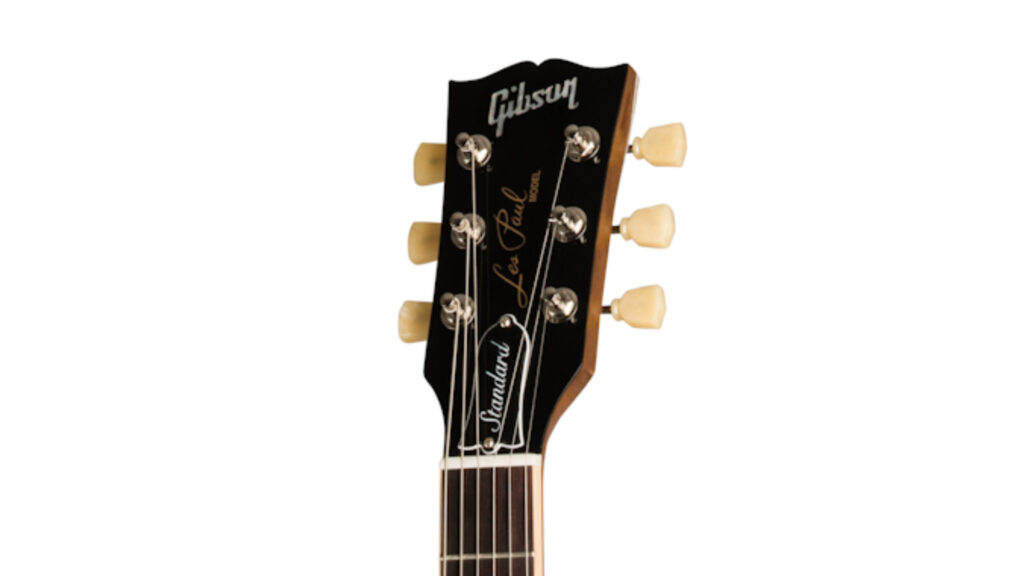
It might anger serious musicians, but I believe we can’t ignore the element of satisfying ownership desires when wanting historical brands like Gibson or Fender. Whether you value an instrument for its sound, playability, appearance, or even its brand is personal. While opinions from senior guitarists around you and online (including my blog) can be references, where you find value in a guitar is something you should decide for yourself. The joy of having the same Gibson as admired guitarists like Jimmy Page (Led Zeppelin) and Slash (Guns n’ Roses) is a unique experience only the Gibson brand can offer. Currently, the Les Paul Standard is manufactured at Gibson’s Nashville factory in the USA.
Orthodox and Luxurious Looks
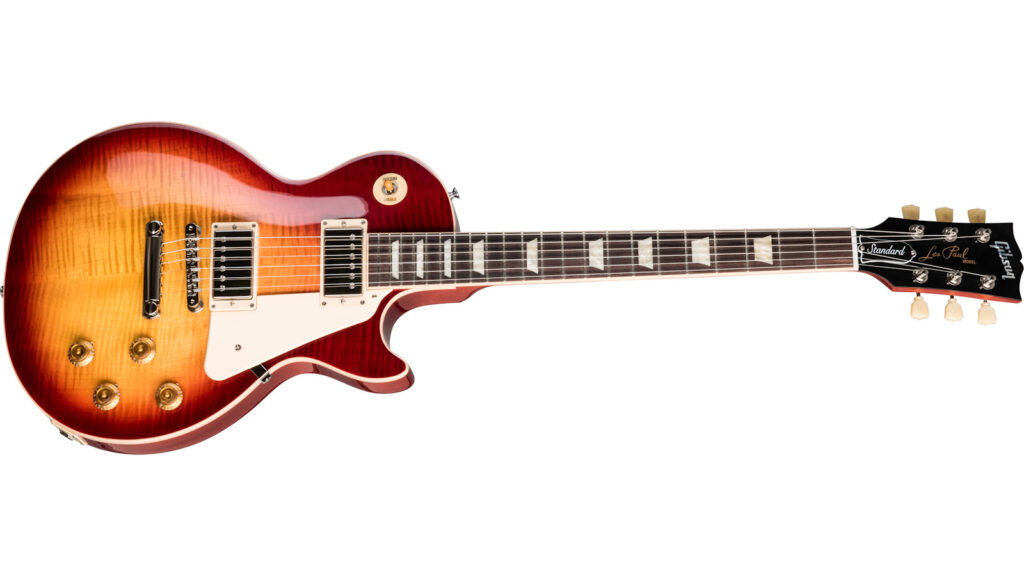
The Gibson Les Paul Standard, within Gibson’s regular lineup, follows a vintage and is the most orthodox specification. With an arched carved maple top, mahogany back body, mahogany neck, rosewood fingerboard, and open book head, it has the looks that say, “This is a Les Paul.” The paint uses nitrocellulose lacquer, and the unique gloss that can’t be achieved with poly paint further enhances its luxury. The Les Paul Standard had been wandering with non-orthodox specifications like robot tuners and zero fret nuts, especially in the 2010s, but the “orthodox Les Paul Standard” returned in 2019 as part of the Original Collection.
Authentic Les Paul Sound
A rich and dense mid-low range that feels good, the authentic Les Paul sound. The balance of the high range, which seems to add gloss without muffling, is also exquisite. And the unique harmonic sensation of Gibson, which can be described as both open and loose, is still alive. It’s authentic, but compared to vintage or custom shop products, it has a slightly organized, sharp, modern-leaning sound. It’s not only good for direct amp connection but also has good compatibility with pedals and digital equipment. It’s an authentic Les Paul sound, so it can handle any genre, whether clean or distorted. The difference in sound between the 50s and 60s will be described later.
High Quality and Easy to Play
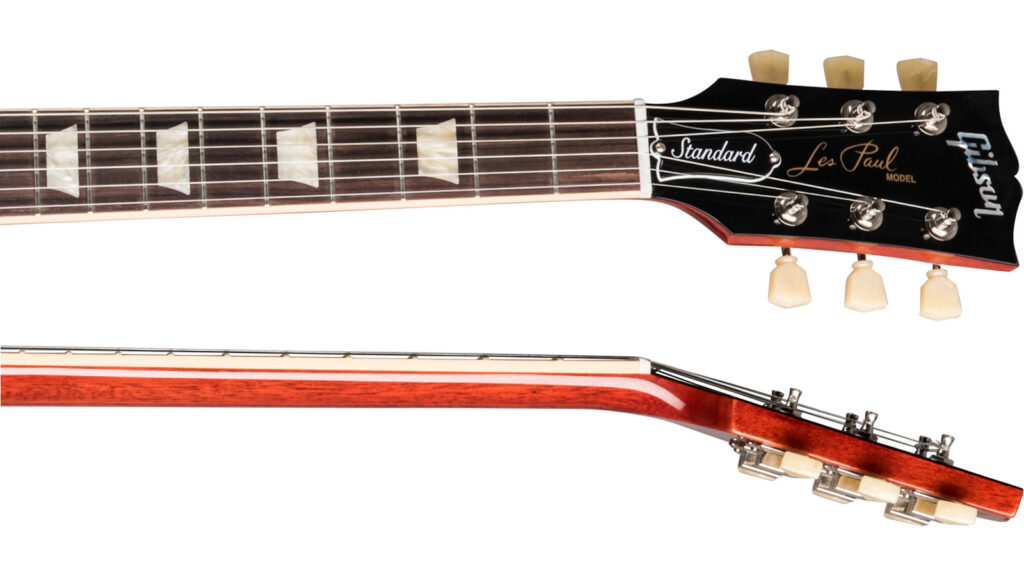
Gibson is sometimes said to be “roughly made” compared to Japanese-made guitars. There may be minor scratches and dirt, but in terms of playability, it’s not like that at all; it’s a quality that allows you to play without stress. There are no issues like the nut groove being too high, making it hard to press down on low chords, or the fret processing being rough, causing the sound to get muffled. With just neck adjustment and bridge height adjustment, it should be set to playability that most guitarists won’t have complaints about. If you’re someone who seeks extremely low string height, where you can produce sound just by touching with your left hand, I recommend buying a modern high-end or Made in Japan guitar. In other words, those who say Gibson’s quality is bad might be those with a modern inclination or those who think it’s cool to deny Gibson without really understanding.
Cons of Gibson Les Paul Standard
- Structural Differences from Vintage
- Unique Playability of Les Paul
Structural Differences from Vintage
The Les Paul Standard follows vintage specifications, but there are differences compared to vintage or custom shop products. For example, hide glue is not used for adhesives; instead, Titebond is used, probably due to manufacturing efficiency and cost. Also, the neck joint is not a long tenon (deep joint). These do affect the sound, but they are not visible, and what’s important is whether the final sound is to your liking. As mentioned earlier, the sound is different from vintage, but it can be said to be easy to handle in modern times.
Unique Playability of Les Paul
Unlike many other guitars, including the Strat, the playability of the Les Paul has a unique quirk. The body, like vintage, is not weight-relieved (the inside of the body is not hollowed out), so when sitting and playing, you might feel the body side sinking. Many guitars are long-scale, but Les Paul is medium-scale. The tension of the strings and the distance to the nut might feel different. Additionally, you may feel hard to play the high position due to a single cutaway. It’s not as quirky as a head-heavy deformed guitar, so if you like it, you will get used to it.
Comparison with Les Paul Standard “Faded”
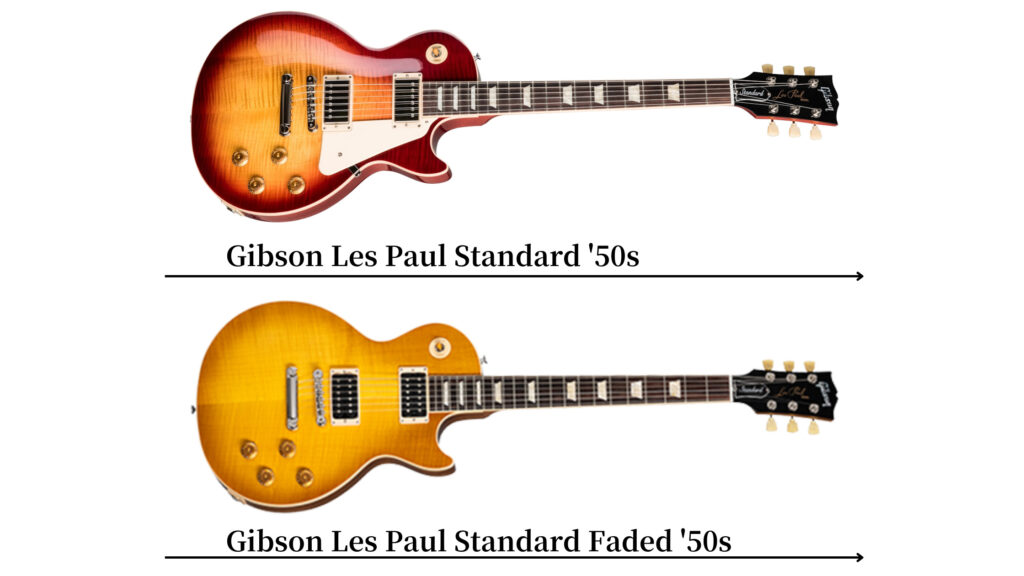
The current Gibson Les Paul Standard lineup includes the Les Paul Standard Faded, which has a simplified paint job. While the basic specs are the same, there are differences between the two models, I describe in the 50s version.
| Specifications | Les Paul Standard | Les Paul Standard Faded |
|---|---|---|
| Market Price | $2,999 | $2,499 |
| Finish | Gloss (shiny) | Satin (matte) |
| Body Back Color | Dyed | None (Natural) |
| Pickup Cover | Yes | No |
| Color | 3 colors each for 50s and 60s | 50s: Vintage Honey Burst 60s: Vintage Cherry Sunburst |
Difference in Appearance
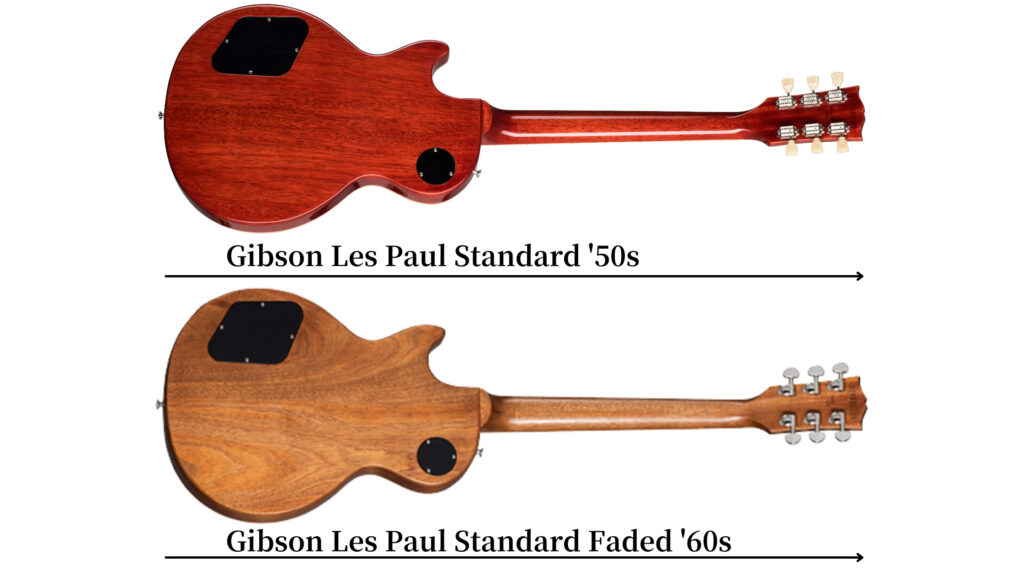
The main difference lies in the appearance. The Faded version has a satin finish without gloss, and the Cherry Sunburst body back is also the color of mahogany without any coloring. The thinner paint makes it easier for scratches to appear. Whether you see this as a disadvantage or as an opportunity to quickly make the guitar uniquely yours is a matter of personal preference. The Faded version offers a slightly different look from the Les Paul Traditional, with a Cherry Sunburst option available for the Faded 60s and a Honey Burst for the Faded 50s. The painting process is simpler, and only one color is available for each model, making the Faded version $500 cheaper than the regular Les Paul Standard. Another difference is the presence or absence of a pickup cover and pickguard. The Faded version doesn’t come with a pickguard installed, but it is included, so you can attach it later if you hope.
Difference in Sound
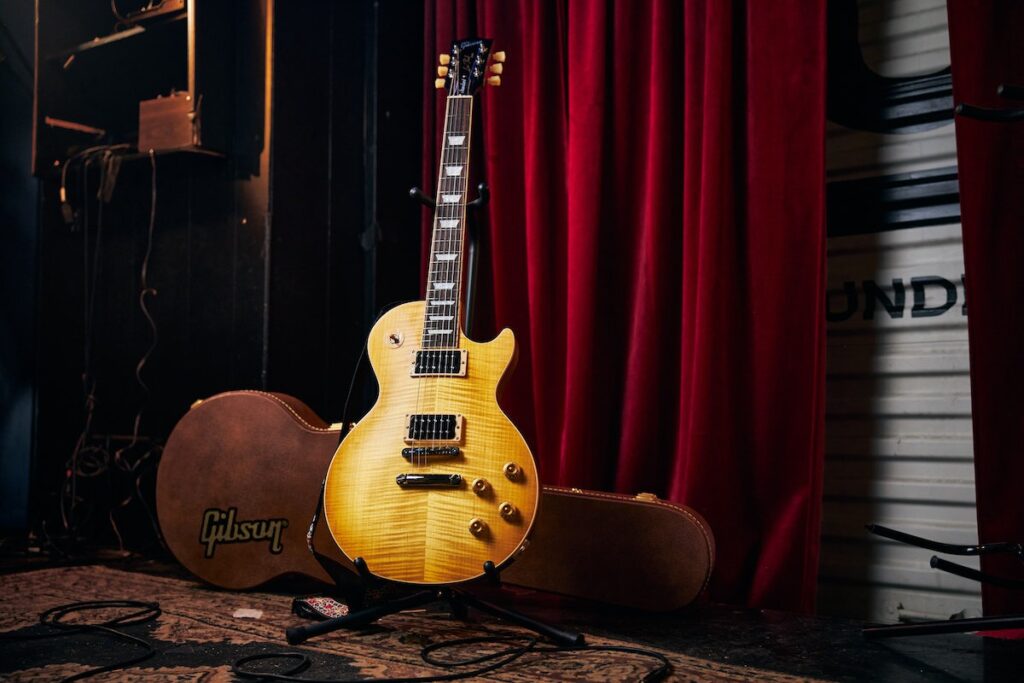
The sound characteristics also differ slightly. The Faded version has a more open sound due to the thinner finish and lack of grain filler. When distorted, it gives a slightly wilder feel.
Difference in Playability
The neck shape is the same as the regular Standard for both the 50s and 60s, but the satin finish of the Faded version feels different to the touch.
Personal Preference: Regular Over Faded
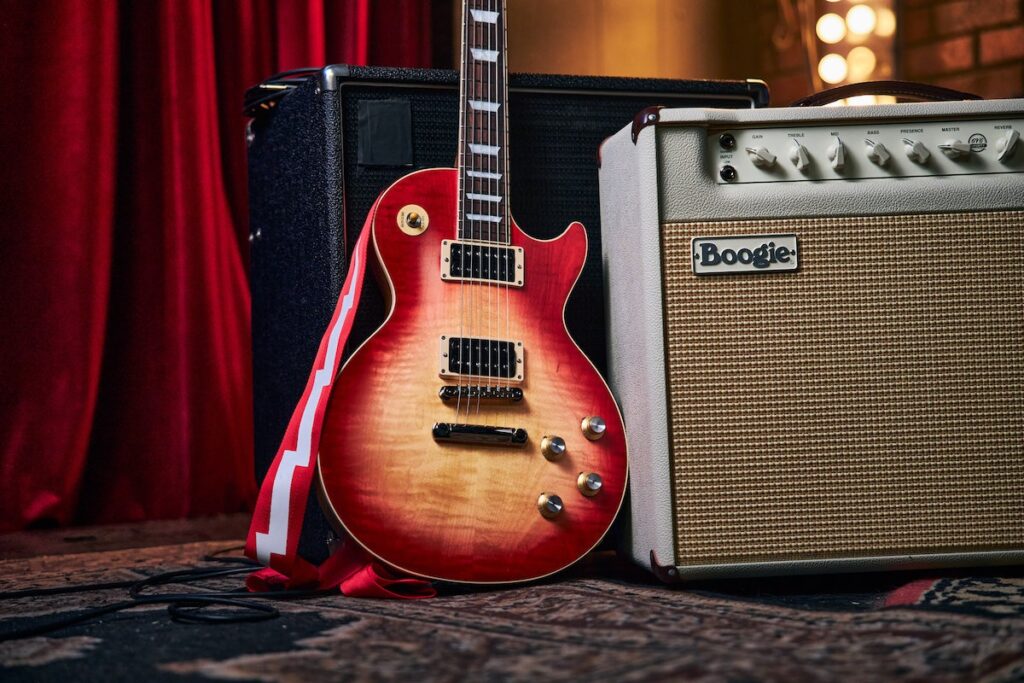
Personally, what I seek in a Gibson Les Paul Standard is the classic feel, so I prefer the regular version over the Faded. The glossy lacquer finish, the colored body back, and the rich sound stand out more in the regular version. There aren’t many Gibson Les Pauls with a satin finish, except for the budget versions.
The Faded version might be suitable for those who
- Like a rougher sound
- Want to quickly age your guitar to make it uniquely yours
- Dislike budget versions but want a Les Paul Standard as cheaply as possible
- Prefer the look of a satin finish
50s vs 60s Comparison
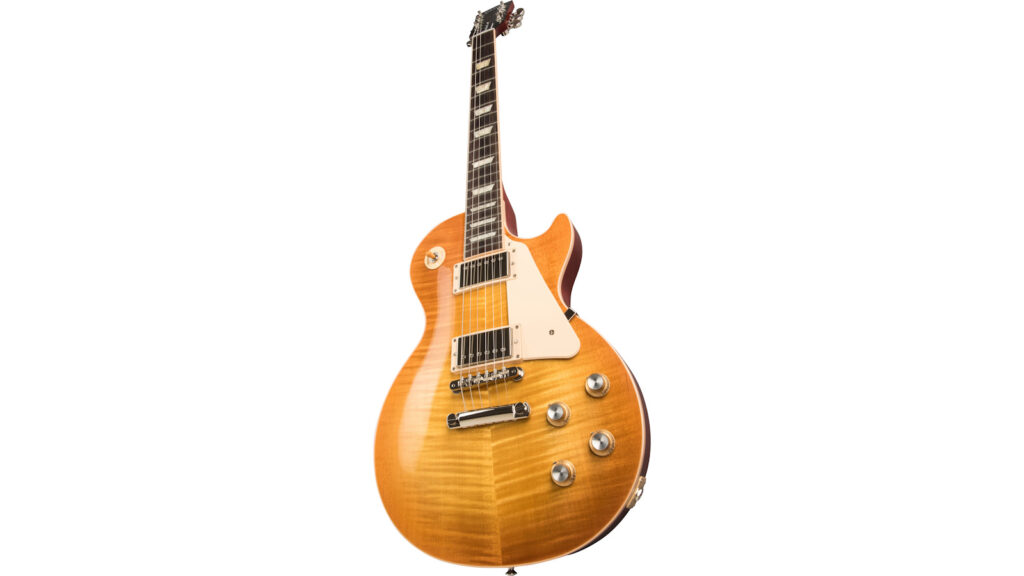
The USA-made Gibson Les Paul Standard lineup includes the 50s and 60s, which replicate the specifications of the 1950s and 1960s, respectively. There are differences beyond just appearance, so let’s delve into them.
Gibson Les Paul Standard Specifications
First, the common specifications are traditional Les Paul features. The glossy finish, inclusion of a hard case, etc., are all fitting for a standard high-end model.
Specifications:
- Les Paul Standard
- Market price: 350,000 to 400,000 yen
- Finish: Gloss nitrocellulose lacquer
- Body top: Maple
- Body back: Mahogany
- Scale length: 24.75″ / 62.865cm
- Fretboard: Rosewood
- Fretboard radius: 12″ / 304.8mm
- Frets: Medium jumbo
- Nut: Graph Tech
- Nut width: 1.695″ / 43.05mm
- Inlays: Acrylic trapezoids
- Bridge: ABR-1 Tune-O-Matic
- Tailpiece: Aluminum stop bar
- Controls: 2 volume, 2 tone & toggle switch (with orange drop capacitors)
- Accessories: Hard case, Gibson accessory kit
50s vs 60s Comparison
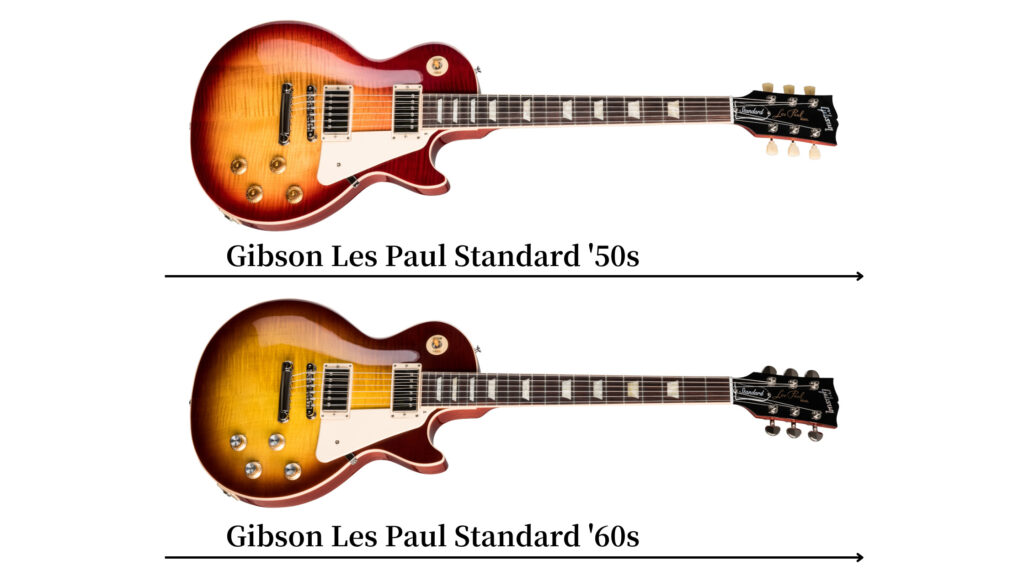
Let’s compare the differences between the 50s and 60s. Broadly speaking, the differences lie in the feel of the neck and the character of the sound due to differences in pickups, pegs, etc.
| Specification | 50s | 60s |
|---|---|---|
| Neck Shape | Vintage 50s | Slim Taper |
| Pegs | Vintage Deluxe w/ Keystone Buttons | Grover Rotomatics w/ Kidney Buttons |
| Neck Pickup | Burstbucker 1 | Burstbucker 61R |
| Bridge Pickup | Burstbucker 2 | Burstbucker 61T |
| Control Knobs | Gold Top Hats w/ Pointers | Gold Top Hats with Silver Reflector & Pointers |
| Color | ● Heritage Cherry Sunburst ● Gold Top ● Tobacco Sunburst | ● Iced Tea ● Bourbon Burst ● Amberburst |
| Characteristics | Solid low-range and dense mid-range, typically thick sound. When distorted, chords might sound muddled, but that’s part of the orthodox Les Paul sound. | More powerful pickups than the 50s. Clear and well-balanced even when distorted. The 60s’ clean sound is less lustrous than the 50s, making it a somewhat modern Les Paul sound. |
Color
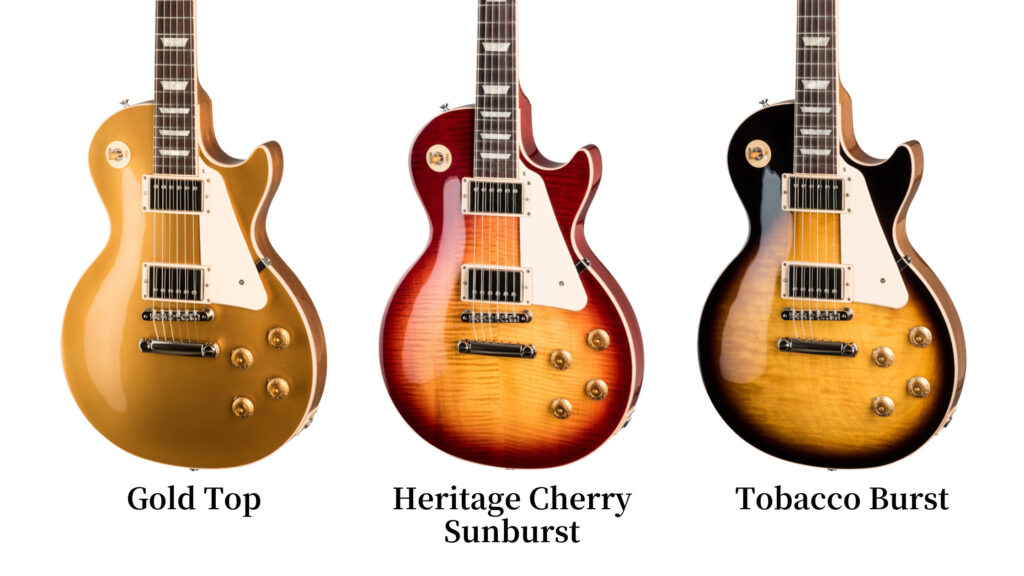
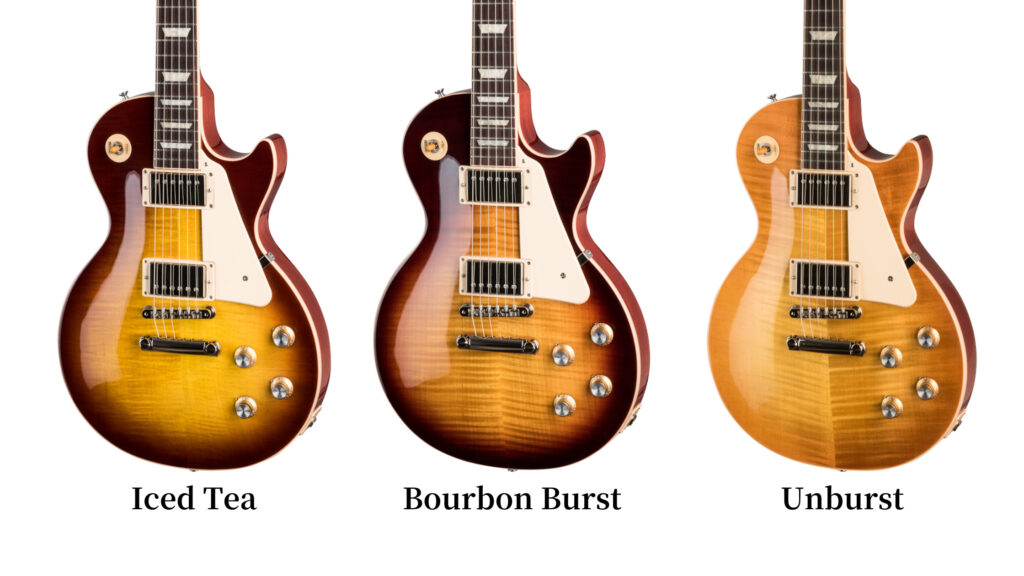
Difference in Appearance
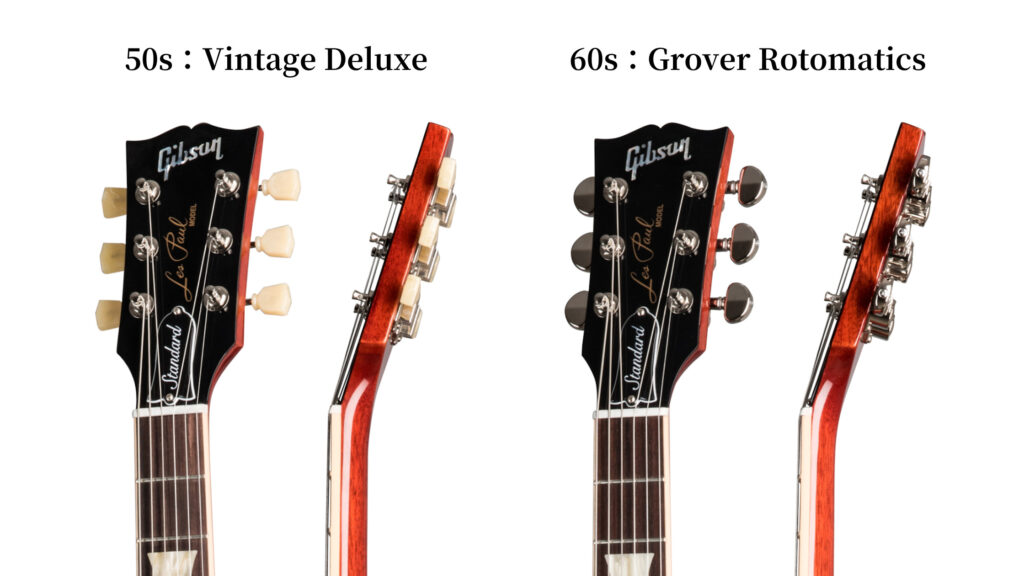
The body color, pegs, and control knobs represent the look of their respective decades. This is entirely a matter of personal preference.
Difference in Playability
The difference in neck shape between the thicker 50s and the thinner 60s affects playability. The 50s Vintage neck shape is rounder and thicker, preferred by rhythm players and blues players. The 60s Slim Taper neck shape is thinner, more like a typical guitar, and is suitable for players who play fast tempos or more complex chords.
Difference in Sound
The combination of pickups and neck thickness results in a difference in sound. The 50s version has a warm and dynamic sound, a thick and rich tone that’s quintessentially Les Paul. The 60s version has a slightly modern sound, clearer and more balanced.
Impressions after playing: If you prioritize nuance, go for the 50s; if you prioritize playability, go for the 60s
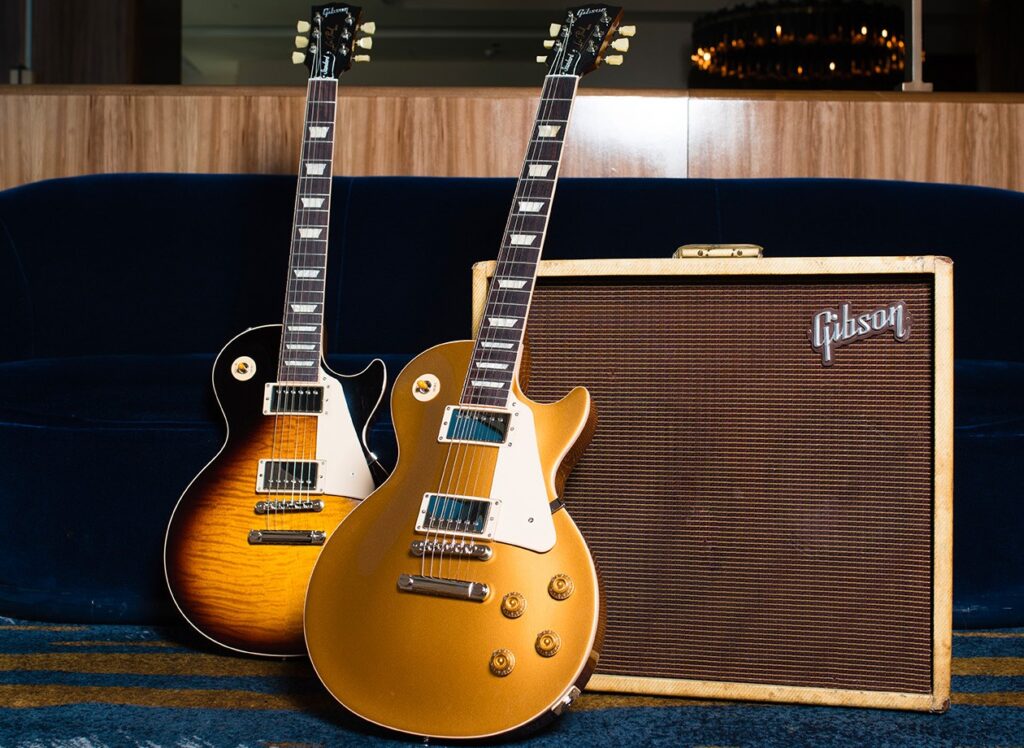
When I actually tried playing both, they indeed both have the authentic sound of a Gibson Les Paul, but their characters are slightly different.
Conclusion:
● 50s … Emphasizes nuance. Vintage-oriented.
● 60s … Easier to play and pairs well with other equipment. Modern-oriented.
The 50s have a rich and full sound, and its output is relatively calm, making it suitable for roots music that emphasizes nuance. The lustrous, rich clean tone that you can’t get with a single coil, which is distinct from the sparkling sound, is a unique charm of the Les Paul. I felt this was the strength of the 50s. When distorted, it has a strong, chunky pressure, which can make chords sound muddy. It would match well with lead play where you adjust the gain with volume control. It’s suitable for players of blues, jazz, soul, and classic rock.
The 60s have a well-balanced Les Paul sound that’s perfect for distortion. Compared to the 50s, the richness, and fullness of the mid-low range are slightly subdued, and you can hear a sharper high range. Therefore, it feels transparent when clean and maintains a wide range when distorted. It’s versatile and doesn’t stick to a particular genre, making it suitable for players who heavily distort or frequently use pedals. It’s suitable for players of rock to hard rock/metal, fusion, and pop.
Personally, I’m not the type to play with strong articulation, so with its standard thin neck shape and somewhat tight sound that doesn’t produce as much nuance as the 50s, I felt the 60s was easier to play in terms of both playability and sound. However, precisely for that reason, if I were to buy a “Gibson Les Paul,” I think I’d prefer the 50s, which has elements that other guitars don’t offer. I already have easy-to-play guitars. If you are not, the 60s is a good choice.

